Bringing the (Optic) Fibre Ensemble to Life - Behind the Scenes of a Telematic Music Performance
Introduction
On Tuesday 22 November 2022 we held our second network musical performance of the semester between the Science Library and RITMO on the UiO campus. Read below to find out about all the technology that went into bringing the music of the newly-formed (Optic) Fibre Ensemble to life.
This concert formed part of a two-day workshop arranged by Çağrı Erdem called Embodied Perspectives on Musical AI. We were the evening’s entertainment for some of the brightest minds in musical machine learning, so the stakes were high.
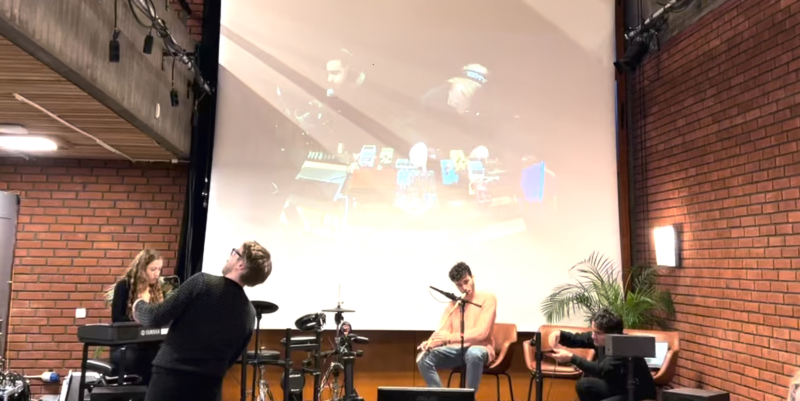
The two locations for this concert were 650m apart, or about 1.9 seconds at the speed of sound. Meanwhile LOLA, the specialist low-latency software we used, allows us to send audio and video between these locations in around 20-30ms.
You can watch the full concert online here as part of the workshop.
Technical Background
This concert was an example of telematic music, or music that is performed between multiple physical locations in real time thanks to network communications technology. We can also call such an event a network musical performance, or NMP. At UiO, we use specialised software called LOLA to stream real-time, high-quality audio and video over a network, meaning performers at both ends can see and hear each other with almost imperceptible latency.
At both locations we used the NMP portable kits. These kits allow us to connect to our UiO LOLA network from a variety of locations around campus, including the two locations for this performance. Our kits include everything we need for a barebones NMP performance, such as the specialised PC, audio interface and camera required by the LOLA software, as well as a 16-channel mixer, a dedicated headphone amplifier, a projector and more. You can read more about the specific equipment included in these kits here.
Science Library
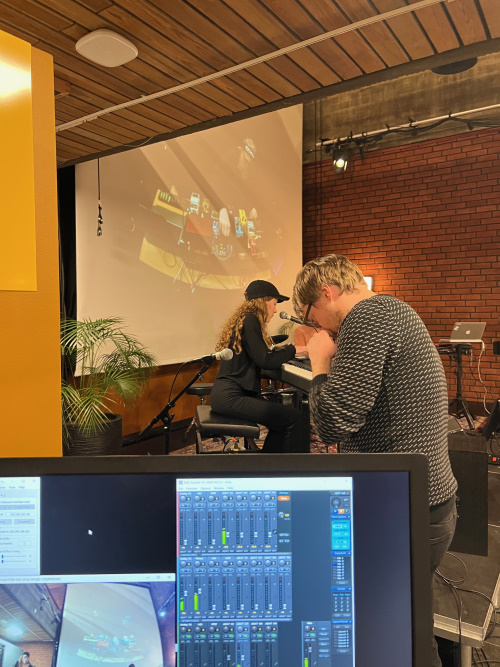
The technical team at the Science Library consisted of our colleagues Alex, Iosif and Aysima. This location served as the front of house for the event, and was also where two of the four performers were located. Nino sang and played piano and guitar, while Emin played the e-drums and ney. Alex was primarily responsible for audio routing and front of house sound, Aysima handled the LOLA software and associated video, and Iosif was in charge of the livestreaming of the event.
The original plan two weeks before the concert was to use a spatial audio system run through a Max patch designed by Masoud. However, we later realised that this was not quite feasible due to the sheer amount of outputs required from the mixer as well as the CPU demands on Masoud’s laptop. As a result, we scaled down our ambitions to an extended stereo system. The wall-mounted speakers in the Science Library provided the majority of the front of house sound, while a pair of large Genelec speakers on the stage were used for the final piece of the concert.
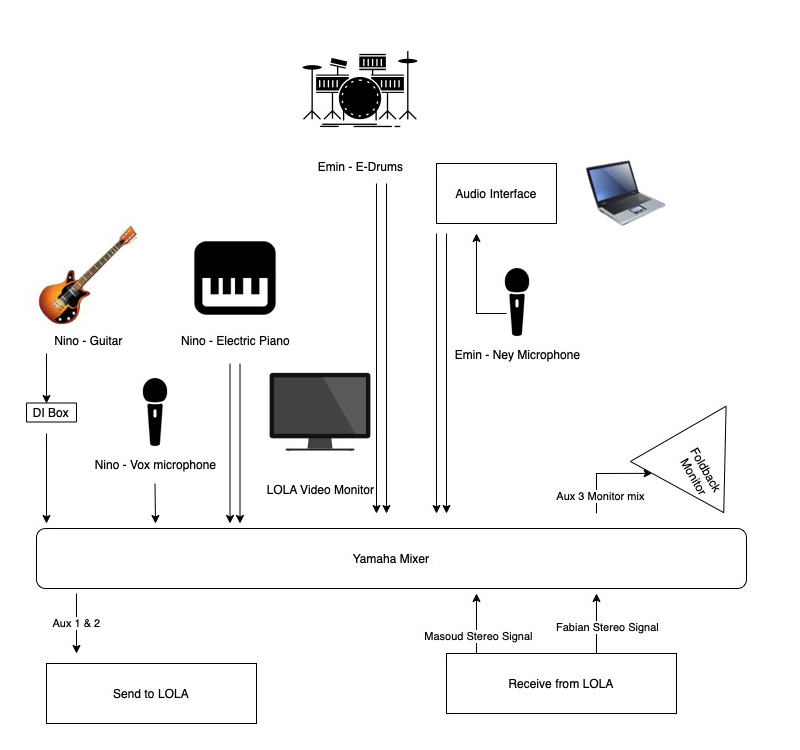
RITMO
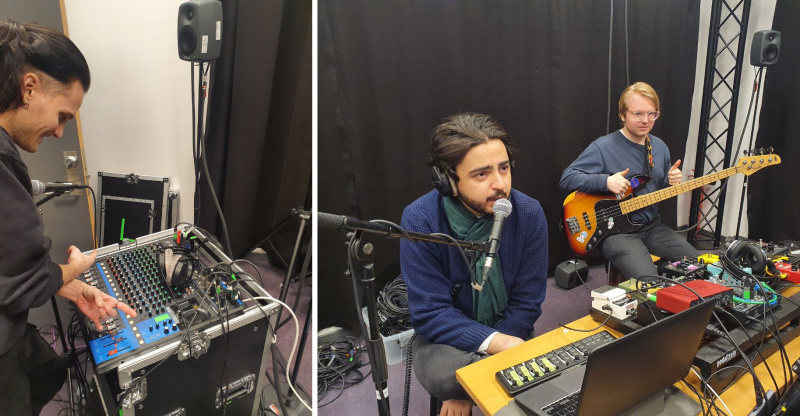
The RITMO technical team consisted of your authors Kristian and Jack, while Masoud and Fabian were the remote performers. Masoud sang and performed a patch in Max/MSP, while Fabian played the bass guitar and the no-input mixing board. Helpfully for the technicians, both of these setups connected to the performers’ audio interfaces. This meant that we only needed to send line inputs into the mixer on the NMP kit and connect a simple Shure SM58 vocal microphone for Masoud.
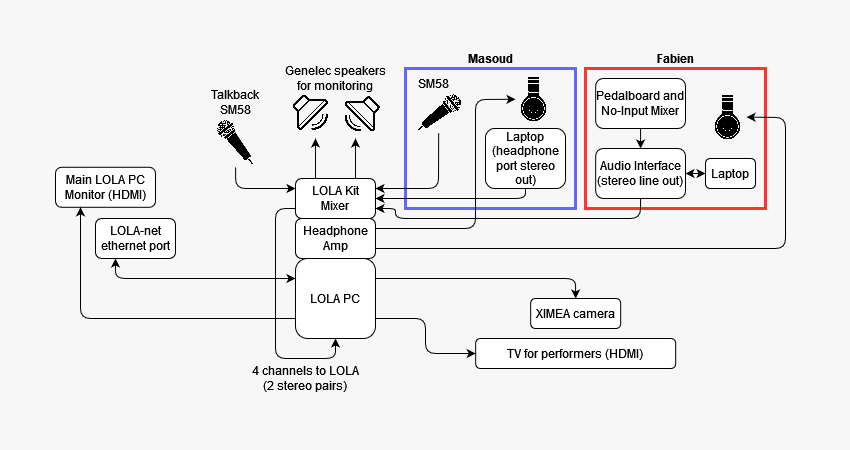
Challenges
We were pleased with how seamless this concert was for the technicians. However, no NMP is ever without its challenges. The technical requirements for the performance shifted significantly in the week prior to the concert, which meant we did not know until we were in the space whether we had all the equipment we needed. Luckily we did not overlook anything major, but nonetheless we learnt that making an exhaustive list of necessary equipment beforehand would have been ideal for peace of mind. Any missing equipment would have been much more problematic if we had been holding the concert outside of the UiO campus, so this was an important lesson to learn going forward.
Conclusion
We had nearly two full days set aside to assemble, rehearse and perform this concert, and it filled a vast majority of it. NMPs certainly take time to get working correctly, but when you get there the results can be brilliant. In this case we were very happy with the concert we managed to pull off, and look forward to getting stuck into more NMP wizardry next semester.
Other Links
- For a full technical breakdown of the concert, read our wiki page here.
- Check the MCT blog for a full report by the performers in this concert. They composed some stunning original music which you should also read about.
